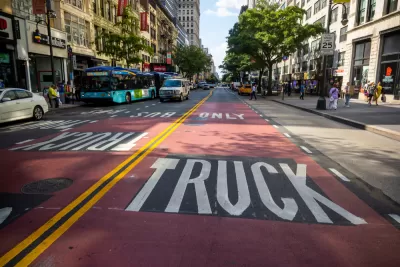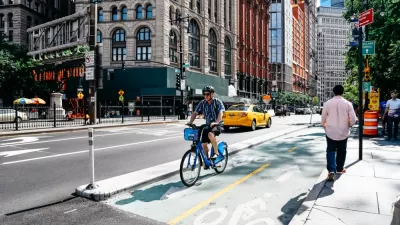Evaluating New York City's new law designed to facilitate bus, pedestrian, and bike travel.

New York City’s mayor recently signed into law a "Streets Master Plan" law to facilitate non-automotive commuting. This law might facilitate bicycle and bus commuting in some major ways. In particular, the new law requires the city’s transportation department to submit a master plan to the city council. The master plan must include, among other things, the following improvements:
*The installation of 250 miles of "protected" bike lane—that is, lanes shielded from traffic by some sort of physical barrier, rather than a mere strip of paint. Bike lanes will make bicycle commuting safer by separating bicycles from auto traffic. If the new bike lanes eliminate driving lanes, cars may go slower, reducing the severity of pedestrian-involved auto crashes.
*Giving transit signal priority to buses for 1,000 intersections along bus routes. "Transit signal priority" means that buses will spend less time stopped at traffic lights, and thus be able to move more rapidly through installations controlled by traffic signals. If this proposal is implemented, bus speeds will increase, causing buses to become more appealing and bus ridership to grow.
*The installation of 150 miles of bus lanes. Giving buses separate lanes from automobiles will also cause bus speeds to increase, thus increasing bus ridership.
All of these reforms, if implemented, will make the city’s buses run more rapidly, and will facilitate biking and walking. By making the least polluting forms of transportation appealing, these reforms may reduce automobile-related pollution, congestion, and injuries. In addition, the bike lanes will help to prevent auto and bike collisions, thus reducing injuries and fatalities.
Nine council members voted against the law. One common objection to the law is that it does not help occupants of "transit deserts" with inadequate subway service. Although many parts of New York's outer boroughs have minimal subway service, many such neighborhoods have bus riders who will benefit from the new law.
For example, Farah Louis of Brooklyn's District 45 complained: "Large swaths of the 45th District have transit deserts — with few train lines and diminishing bus service, my constituents have no choice but to drive." This argument lacks merit for two reasons. First, the claim that Louis's "constituents have no choice but to drive" is wrong. Louis's office is in zip code 11203. According to the American Community Survey, only 30 percent of this zip code's residents use a car to get to work, and 47 percent of households in the zip code do not even own a vehicle. Her own office is served by the B8 bus route, which runs every ten or 12 minutes during the day and every 20 minutes at night until midnight.
Second, improved bus and bike lanes are a step in solving the "transit desert" problem by making buses and bikes more convenient. To use inadequate buses as a reason to oppose better buses makes no sense.
Councilman Steven Matteo of Staten Island complained, "A one-size-fits-all mandate simply does not work for Staten Island." If the bill had stated that X numbers of bike lanes should go in every neighborhood, this argument might make sense. The bill doesn't, so the argument doesn't either.
Councilman Daneek Miller also complained that Queens residents, Miller's constituents, live in a transit desert, stating that a "plan that does not thoughtfully rectify this by providing adequate funding for buses and infrastructure is something that we cannot support.” Although more bus service is certainly a good thing, fast but inadequate bus service is certainly better for riders than slow and inadequate bus service.
Because the objections to the law are unpersuasive, it seems to me that New York's law is both beneficial to New Yorkers and a role model for any city that desires better bikes and buses.
But it also seems to me that New York's law has three weaknesses that the city should address.
First, the city can draft a plan but that doesn’t mean the plan will be funded. The city’s fiscal impact statement states that the plan will cost $628 million in its first five years. Where will this money come from?
Second, how do we know the plans will be implemented? How will the city decide where the bus lanes or bike lanes go? What happens if neighborhood residents protest against a city’s proposed locations for these amenities?
Third, how can the city ensure that the city transit authority (the MTA) doesn't cut service? A fast bus is a fine thing, but if it only runs once an hour, it will nevertheless have low ridership.
In sum, the city's new law is a fine start, and residents of other cities should consider similar proposals.

Alabama: Trump Terminates Settlements for Black Communities Harmed By Raw Sewage
Trump deemed the landmark civil rights agreement “illegal DEI and environmental justice policy.”

Study: Maui’s Plan to Convert Vacation Rentals to Long-Term Housing Could Cause Nearly $1 Billion Economic Loss
The plan would reduce visitor accommodation by 25% resulting in 1,900 jobs lost.

Planetizen Federal Action Tracker
A weekly monitor of how Trump’s orders and actions are impacting planners and planning in America.

Waymo Gets Permission to Map SF’s Market Street
If allowed to operate on the traffic-restricted street, Waymo’s autonomous taxis would have a leg up over ride-hailing competitors — and counter the city’s efforts to grow bike and pedestrian on the thoroughfare.

Parklet Symposium Highlights the Success of Shared Spaces
Parklets got a boost during the Covid-19 pandemic, when the concept was translated to outdoor dining programs that offered restaurants a lifeline during the shutdown.

Federal Homelessness Agency Places Entire Staff on Leave
The U.S. Interagency Council on Homelessness is the only federal agency dedicated to preventing and ending homelessness.
Urban Design for Planners 1: Software Tools
This six-course series explores essential urban design concepts using open source software and equips planners with the tools they need to participate fully in the urban design process.
Planning for Universal Design
Learn the tools for implementing Universal Design in planning regulations.
Caltrans
Smith Gee Studio
Institute for Housing and Urban Development Studies (IHS)
City of Grandview
Harvard GSD Executive Education
Toledo-Lucas County Plan Commissions
Salt Lake City
NYU Wagner Graduate School of Public Service






























